Photography by Joseph M. Erickson, Crista V. Worthy, and Darlene Kellog Rudisill
It’s nearly 9 p.m., yet the sun still hangs high in the sky. As usual when I’m in an airliner, my face is pressed to the window. I want to see every acre of terrain below, understand how it all fits together. After years of flying Cessnas, I have most of America’s topography west of the Rockies permanently etched into memory. One of the last missing pieces lies just ahead—Alaska’s Kenai Peninsula. As we descend toward Anchorage, I look north and am rewarded with a view of Mount McKinley, 130 miles away.
But I haven’t come to visit the great mountain. That’s for another time. I’m here to get my wings back, and I’ve chosen the most fun and challenging place I can think of to do it—the front seat of a Piper Super Cub. On floats. In tight canyons, surrounded by glaciers and rugged mountains. With Alaska’s legendary flight instructor and pilot examiner, Vern Kingsford, at his Alaska Float Ratings flight school (www.alaskafloatratings.com).
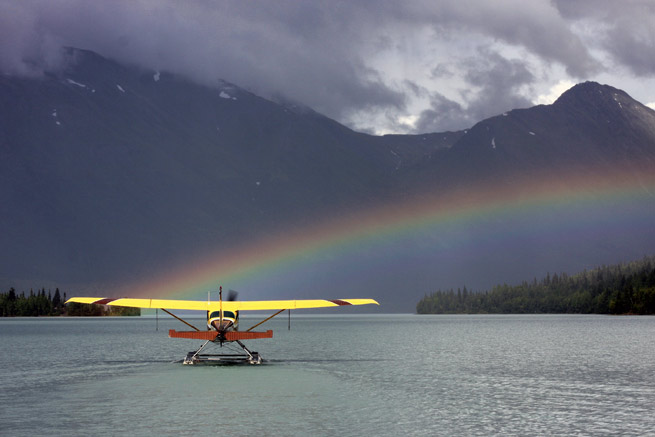
Into the skies again
After a decade of adventures throughout the west my husband and I sold our Cessna 210 to start a new business, and moved from California to Idaho. Now, it’s time to start flying again. Why not try for a seaplane rating along with that flight review? And why not go where Paul Klaus, famed bush pilot with 27,000 hours of backcountry flying, got his rating? More recently, Icon Aircraft, developing a new amphibious LSA, sent a 20-year veteran Naval aviator with more than 750 carrier landings to Alaska Float Ratings so he could earn his seaplane rating with Kingsford and then help Icon develop its training curriculum. Kingsford, 75, has been a pilot for 50 years. His experience is vast.
It’s a 40-minute flight from the Lake Hood seaplane base at Anchorage to the flight school in Moose Pass, 30 miles north of Seward. Evan Gardner, one of the CFIs, installs me in the left seat of a float-equipped, modified Cessna 172. “This is the first time I’ve ever been in a floatplane,” I tell him, and he smiles. And then we’re up over the lake, and I see perhaps 300 seaplanes docked below, with rows of taildraggers parked behind them. Minutes after leaving Anchorage airspace, we’re over wilderness and down between the peaks of the Chugach, clad in their summer green, with waterfalls cascading down every crevice. We descend toward Moose Pass and set down on the aquamarine Upper Trail Lake. Kingsford is there to meet us as we glide slowly, engine off, toward the dock.
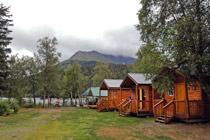
My home is one of three log cabins reserved for students, just steps away from the dock and office. A lodge with a restaurant, a mini mart, and a fudge shop are a five-minute walk and constitute the entirety of Moose Pass business establishments, other than the flight school, which also operates a charter and flightseeing service. The popular “Optimal Float Course with Lodging” includes 10 hours of flight time (enough for most students to fit in an incredible scenic flight after earning their rating) and four nights in a cabin for $3,399. Shorter courses are available.
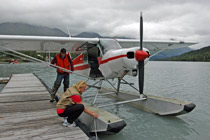
The next morning I walk over to the office and ground school room, where Darlene Kellogg-Rudisill, chief pilot, is waiting to take me up for the first time. Autographed photos of astronauts and fighter pilots, all past students, line the office walls. We don comfortable inflatable life jackets and walk down to the dock, where I learn how to preflight “VK,” Kingsford’s favorite of the three Super Cubs. I sit in front and wonder whether the stick and the throttle positioned below the left window will feel odd, since my experience is all in Cessnas. Kellogg-Rudisill taxis out, takes off, and soon says, “You have the controls.” It’s exciting and I’m just hanging on for the first few stalls and steep turns. I have years of rust to knock off. But before I know it we’re winging around with the ball centered and the altimeter steady. I haven’t even given the stick or throttle a thought. They feel completely natural, and my feet are coming alive again. And I can’t wipe the smile off my face. Even with floats, the 160-horsepower Lycoming O-320 provides ample power and the PA–18 is highly maneuverable, with excellent visibility on both sides.
Unique perspective
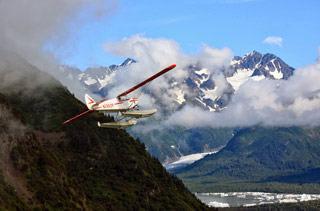
Between flights there is time to ask the CFIs any questions, have lunch, or retire to the cabin to study and review. My afternoon flight is with Phil Thibodeau; multiple CFIs and aircraft are another advantage of this program. Each CFI offers a unique perspective. This aircraft has a different instrument arrangement and floats that sit higher in the water. Before we get in, we look at the lake and note the wind and clouds.
We push off and I feel a bit like I’m drinking from a fire hose: with no brakes, we are moving as I get the door locked, seatbelt fastened, headset on, and then run the checklists from memory for the first time—including a runup that’s done while moving—before I prepare for my first takeoff.
The stick is kept back to keep spray off the prop, as water can damage it almost like gravel. The Cubs are my first carbureted airplanes and I remember to turn off the carb heat; the water rudders need to come up before takeoff, and it’s all going well until I add power and Thibodeau barks, “Abort!” How embarrassing—I was just about to take off downwind. Welcome to float flying, where there is no runway and you have to make conscious decisions about everything, all the time, including exactly where to take off and land, and in what direction. Rudders back down so we can maneuver into the wind, and then the takeoff goes well.
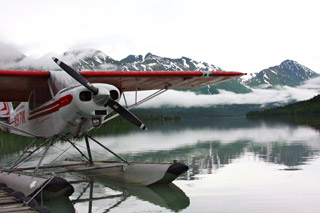
The flight training is incredibly time efficient. From AFR’s docks on Upper Trail Lake, about a dozen sparkling lakes of varying size, shape, and color lie within a few minutes’ flight. At any moment, all may have different wind patterns, constantly in flux because of canyons and terrain oriented in different directions. Winds can change even while in the pattern over a lake. If your fancy panel has been keeping your eyes in the cockpit, you’ll be cured of that here. It’s all outside—not just incredible beauty, such as the blue hanging glaciers we flew past one day, but the cues needed to make proper decisions.
The course also is a mountain flying course. Pilots learn how to stay to one side in canyons, operate in confined spaces, and predict up- and downdrafts caused by shifting winds and mountains that tower up to a mile above the lakes. From 500 feet agl, we examine the lake for obstructions and wind patterns, then land parallel to the shoreline. We go for normal, rough water, and confined-area takeoffs and landings. We fly short patterns to save time and improve confined-area skills, particularly important with surrounding high terrain.
When the ceiling drops we practice “low water work,” an accelerated learning technique where you attempt to maintain flight exactly four inches above the water using stick and throttle. This helps lock in the visual of the correct attitude for landing, takeoff, and step taxiing. It’s an impossible exercise, so you’ll touch occasionally and develop touchdown awareness. On an eight-mile stretch of Kenai Lake, you could touch down 40 times. It’s also a blast.
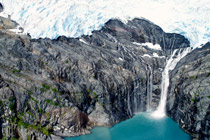
The roller coaster
The next day brought foul weather so I studied, visited town, and walked to a creek loaded with spawning sockeye, bright red and with sharp teeth protruding from crooked jaws. The area is home to moose, bald eagles, and bears—one visited the docks a couple of years ago. When the wind calmed, it was time for glassy water landings on the bright turquoise Grant Lake. It’s true: you really can’t tell how high above the water you are when it’s glassy. Instead, you pick a reference point on shore (a tree is handy), descend until you’re abeam of it, pitch into landing attitude, and fly the airplane down onto the lake using power to control the descent. You monitor your height by watching the trees alongside, until you feel touchdown.
We practiced engine failures inside canyons, so I learned to make a rapid turn and land without power. But my favorite exercise was the Roller Coaster. Has your CFI ever failed your engine at 100 feet after takeoff? Sure, you can try it at altitude or in a simulator, but it’s not the same. Push forward immediately, as you should, and the ground (or, in this case, water) seems to rush toward you—a sight now permanently etched into my brain. I had to resist the urge to pitch up, and instead waited until the perfect moment to pull the stick back, get the Super Cub into landing attitude, and gently set the floats down on the water. Then we’d power back up, take off, and pull the power to idle again at 100 feet for another simulated engine failure. Doing this over and over programs the correct actions into muscle memory.
Kingsford generally flies with each student before the checkride but, as the DPE, avoids becoming too chummy with students until their checkrides are completed, to maintain objectivity. On our first flight together, after failing the engine a couple of times, he directed me to fly over two lakes I hadn’t seen: the miniscule Johnson Lake, and just past it, the only slightly less miniscule Bench Lake. They lay in a deep, narrow canyon and were surrounded by neon-green grass and purple fireweed.
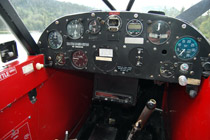
As we passed over the far shoreline of Bench Lake, Kingsford said, “Pull the mixture. I have the airplane.”
“You have the airplane,” I replied, as I pulled the mixture and let go of the stick. The prop stopped as Vern pushed us over to maintain glide speed while expertly turning a hard left 180-degree turn in the narrow canyon. He then S-turned, managing our stored kinetic energy perfectly, and set the airplane down gently on the lake. We opened the door and took in the utter stillness around us. Aside from ourselves and the aircraft, there was no evidence of humankind. A high-finned Arctic grayling surfaced for a fly off the starboard float. “Tons of them in here,” Vern said, “This place is a fisherman’s paradise.”
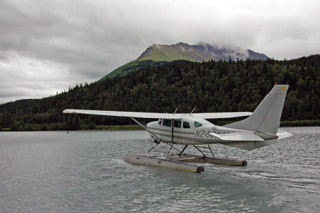
When we returned I was told I’d take my checkride in an hour. I went into my cabin, sat down, and visualized everything I would need to do, in real time, talking out loud, and making proper hand motions. The checkride was no walk in the park. Kingsford made several attempts to cause confusion, task overload, or get me to skip checklist items. He knows the PIC must be able to perform under pressure. But the training and visualization all came together. I made no mistakes and finessed every landing velvety-soft. “I can tell you really love to fly,” Kingsford said as he congratulated me on earning the rating. I beamed. The past 10 hours of flight time were the most fun I’d ever had flying; I’m hooked on floats!
More observations
Finish your training early or stay an extra day and you can fly over the Harding Icefield’s mind-boggling glaciers and over the iceberg-laden Prince William Sound, sights that don’t exist in the lower 48.
The seaplane training hugely improved my stick and rudder skills, which were lazy after flying a Cessna 210 for a decade. Even at regular airports, where the runway is dictated for me, I’ve become much more observant of the surrounding environment before and during my flights, and much more aware of my decision-making process—two of the ultimate keys to flying safely. For me, float flying in rugged Alaska is the ultimate flying adventure. I can’t wait to go back.
Crista V. Worthy is the managing editor of Pilot Getaways magazine and editor of The Flyline, the monthly publication of the Idaho Aviation Association.


